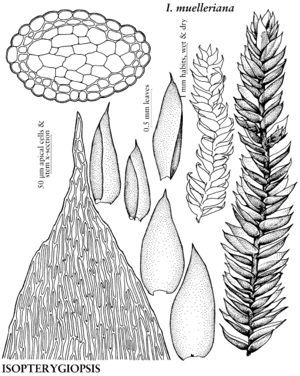Isopterygiopsis
J. Hattori Bot. Lab. 33: 379, fig. 21. 1970.
| Taxon | Illustrator ⠉ | |
|---|---|---|
 | Isopterygiopsis muelleriana | Patricia M. Eckel |
 | Isopterygiopsis pulchella | Patricia M. Eckel |
Plants small, in thin to dense mats, light green to yellowish, glossy. Stems creeping, simple or sparingly and irregularly branched; hyalodermis present, sometimes indistinct, central strand sometimes present; paraphyllia and pseudoparaphyllia absent. Stem and branch leaves similar, erect-spreading, occasionally secund, not undulate, lanceolate or ovate to oblong-lanceolate, not plicate; base not decurrent; margins plane to erect, entire or minutely serrulate; apex long-acuminate to abruptly acuminate; ecostate or costa double, short; alar cells not differentiated or sometimes quadrate to short-rectangular; laminal cells smooth or minutely prorulose at distal and proximal ends on abaxial surface. Specialized asexual reproduction sometimes present as cylindric or fusiform brood bodies in clusters in leaf-axils on stems and branches. Sexual condition autoicous or dioicous; perichaetial leaves small, lanceolate to ovate, apex acuminate to abruptly filiform-acuminate. Seta red to brown. Capsule erect to cernuous, oblong to ovoid, straight to subarcuate, contracted below mouth and wrinkled at neck when dry; annulus 2-seriate or 3-seriate, deciduous; operculum conic to obliquely rostrate; peristome double; exostome teeth with external surface cross-striolate proximally, papillose distally; endostome basal membrane high to low, segments keeled, cilia shorter than segments, in groups of 1–3, sometimes absent. Calyptra naked. Spores spheric to ovoid, smooth or minutely papillose.
Distribution
North America, c, e Mexico, South America, Europe, Asia, Africa, Pacific Islands (New Zealand)
Discussion
Species 3 (3 in the flora).
Isopterygiopsis occurs in terrestrial habitats in boreal and temperate woods, as well as in the Arctic. The stems have small to large epidermal cells with thin exterior walls and thick interior walls; the axillary hairs are hyaline, with one short-rectangular basal cell and two elongate distal cells; and the papillose rhizoids are in clusters in the leaf axils. The leaves are symmetric, sometimes with 1–3 alar cells on the margins that are differentiated from the often flexuose, linear-fusiform laminal cells. The green to yellowish green brood bodies are cylindric or fusiform, and of 2–6 smooth cells. The inflorescences are clumped at the bases of stems and branches; the setae are twisted; the capsules are smooth with a few superficial stomata in the neck; and the exostome teeth are bordered and internally trabeculate.
Selected References
None.
Key
| 1 | Stems complanate-foliate; leaf apices often abruptly acuminate. | Isopterygiopsis muelleriana |
| 1 | Stems not complanate-foliate; leaf apices gradually acuminate | > 2 |
| 2 | Leaf margins entire or minutely serrulate near apex; medial laminal cells 96-156 µm. | Isopterygiopsis pulchella |
| 2 | Leaf margins serrulate distally; medial laminal cells 33-61 µm. | Isopterygiopsis alpicola |